A Composite Permeable Sloping Seawall for Effective Energy Dissipation: A Quasi-Soft Alternative Solution for Shore Protection
Abstract
:1. Introduction
2. Governing Parameters
3. Materials and Methods
Experimentation
4. Results and Discussion
4.1. Effect of Relative Water Depth on the Reflection Coefficient
4.2. Effect of the Surf Similarity Parameter on the Reflection Coefficient
4.3. Wave Energy Dissipation
4.4. Comparison with Results Obtained by Formulae from Literature
4.5. Hydrodynamic Performance Evaluation
5. Conclusions
Author Contributions
Funding
Institutional Review Board Statement
Informed Consent Statement
Data Availability Statement
Conflicts of Interest
Appendix A
References
- Kudale, M.D.; Mahalingaiah, V.; Tayade, B.R. Use of sand-filled geotextile tubes for sustainable coastal protection- case studies in Indian scenario. Indian J. Mar. Sci. 2014, 2014, 5–7. [Google Scholar]
- Lee, S.C.; Hashim, R.; Motamedi, S.; Song, K.-I. Utilization of Geotextile Tube for Sandy and Muddy Coastal Management: A Review. Sci. World J. 2014, 2014, 1–9. [Google Scholar] [CrossRef] [PubMed] [Green Version]
- Khare, K.C.; Dabir, V.V. Geosynthetics in coastal protection: An Indian Overview. In Proceedings of the International Conference on Hydraulics, Water Resources and Coastal Engineering (Hydro2016), CWPRS, Pune, India, 8–10 December 2016; pp. 683–689. [Google Scholar]
- Faure, Y.-H.; Ho, C.C.; Chen, R.-H.; Le Lay, M.; Blaza, J. A wave flume experiment for studying erosion mechanism of revetments using geotextiles. Geotext. Geomembr. 2010, 28, 360–373. [Google Scholar] [CrossRef]
- Hornsey, W.; Carley, J.; Coghlan, I.; Cox, R. Geotextile sand container shoreline protection systems: Design and application. Geotext. Geomembr. 2011, 29, 425–439. [Google Scholar] [CrossRef]
- Kriel, H.J. Hydraulic Stability of Multi-Layered Sand-Filled Geotextile Tube Breakwaters under Wave Attack. Ph.D. Thesis, Stellenbosch University, Stellenbosch, South Africa, 2012. [Google Scholar]
- Palmeira, E.M.; Tatto, J. Behaviour of geotextile filters in armoured slopes subjected to the action of waves. Geotext. Geomembr. 2015, 43, 46–55. [Google Scholar] [CrossRef]
- Recio-Molina, J.; Yasuhara, K. Stability of modified geotextile wrap-around revetments (GWR) for coastal protection. Geosynth. Int. 2005, 12, 260–268. [Google Scholar] [CrossRef]
- Shin, E.; Oh, Y. Coastal erosion prevention by geotextile tube technology. Geotext. Geomembr. 2007, 25, 264–277. [Google Scholar] [CrossRef]
- Mallayachari, V.; Sundar, V. Reflection characteristics of permeable seawalls. Coast. Eng. 1994, 23, 135–150. [Google Scholar] [CrossRef]
- Neelamani, S.; Sandhya, N. Wave reflection characteristics of plane, dentated and serrated seawalls. Ocean Eng. 2003, 30, 1507–1533. [Google Scholar] [CrossRef]
- Negm, A.; Nassar, K. Determination of Wave Reflection Formulae for Vertical and Sloped Seawalls Via Experimental Modelling. Procedia Eng. 2016, 154, 919–927. [Google Scholar] [CrossRef] [Green Version]
- Nassar, K.; Mahmod, W.E.; Tawfik, A.; Rageh, O.; Negm, A.; Fath, H. Developing empirical formulas for assessing the hydrodynamic behaviour of serrated and slotted seawalls. Ocean Eng. 2018, 159, 388–409. [Google Scholar] [CrossRef]
- Esmaeili, M.; Rahbani, M.; Khaniki, A.K. Experimental investigating on the reflected waves from the caisson-type vertical porous seawalls. Acta Oceanol. Sin. 2019, 38, 117–123. [Google Scholar] [CrossRef]
- Lal, D.; Sankar, N.; Chandrakaran, S. Interface shear behaviour of coir geotextiles and sand using large-scale direct shear tests. Aust. Geomech. J. 2017, 52, 75–84. [Google Scholar]
- Sun, J.; Huang, Y. Modeling the Simultaneous Effects of Particle Size and Porosity in Simulating Geo-Materials. Materials 2022, 15, 1576. [Google Scholar] [CrossRef]
- Chakrabarthi, S. Hydrodynamics of Offshore Structures, 2nd ed.; Henry Ling Ltd.: Dorechester/London, UK, 1985. [Google Scholar]
- Dean, R.G.; Dalrymple, R.A. Water Wave Mechanics for Engineers and Scientists; World Scientific: Singapore, 1984. [Google Scholar]
- Antonio, J.; Molina, R. Hydraulic Stability of Geotextile Sand Containers for Coastal Structures—Effect of Deformations and Stability Formulae. Coast. Eng. 2008, 1, 3805–3817. [Google Scholar]
- Oumeraci, H.; Kortenhaus, A. Core made of geotextile sand containers for rubble mound breakwaters and seawalls: Effect on armour stability and hydraulic performance. Ocean Eng. 2011, 38, 159–170. [Google Scholar] [CrossRef]
- Reedijk, B.; Muttray, M.; Van Den Berge, A.; De Rover, R. Effect Of Core Permeability on Armour Layer Stability. Coast. Eng. 2008, 1, 3358–3367. [Google Scholar]
- Munireddy, M.G.; Neelamani, S. Wave Transmission and Reflection Characteristics of a Partially Immersed Rigid Vertical Barrier. Ocean. Eng. 1992, 19, 313–325. [Google Scholar]
- Dabir, V.; Deki, S.; Agarwal, K.; Ranjan, A.; Khare, K. Permeability of A Composite Seawall: Effect of the Orientation of Gaps in the Structure. IOP Conf. Ser. Earth Environ. Sci. 2020, 527, 012004. [Google Scholar] [CrossRef]
- Gimenez-Curto, L. Behaviour of Rubble Mound Breakwaters under Wave Action. Ph.D. Thesis, University of Santander, Cantabria, Spain, 1979. [Google Scholar]
- Zanuttigh, T.L.; Andersen, B. Wave reflection in 3D conditions. Coast. Eng. 2010, 57, 531–538. [Google Scholar] [CrossRef]
- Seelig, W.N.; Ahrens, J.P. Estimation of Wave Reflection and Energy Dissipation Coefficients for Beaches, Revetments, and Breakwaters; US Army Corps of Engineers: Washington, DC, USA, 1981; Volume 81, pp. 1–41.
- Burger, W.; Oumeraci, H.; Partenscky, H.W. Geohydraulic Investigations of Rubble Mound Breakwaters. In Proceedings of the 21st International Conference on Coastal Engineering, Sol-Malaga, Spain, 20–25 June 1988; p. 166. [Google Scholar]
- Postma, G. Wave Reflection from Rock Slopes under Random Wave Attack. Master’s Thesis, Delft University of Technology, Delft, The Netherlands, 1989. [Google Scholar]
- Van der Meer, J.W.; Stam, C.M. Wave Runup on Smooth and Rock Slopes of Coastal Structures. J. Waterw. Port Coast. Ocean Eng. 1992, 118, 534–550. [Google Scholar] [CrossRef]
- Hughes, S.A.; Fowler, J.E. Estimating Wave-Induced Kinematics at Sloping Structures. J. Waterw. Port Coast. Ocean Eng. 1995, 121, 209–215. [Google Scholar] [CrossRef]
- Van der Meer, J.W.; Allsop, N.W.H.; Bruce, T.; De Rouck, J.; Kortenhaus, A.; Pullen, T.; Schüttrumpf, H.; Troch, P.; Zanuttigh, B. Manual on wave overtopping of sea defences and related structures. An overtopping manual largely based on European research, but for worldwide application. EurOtop. 2018. Available online: https://biblio.ugent.be/publication/8506110 (accessed on 3 September 2022).
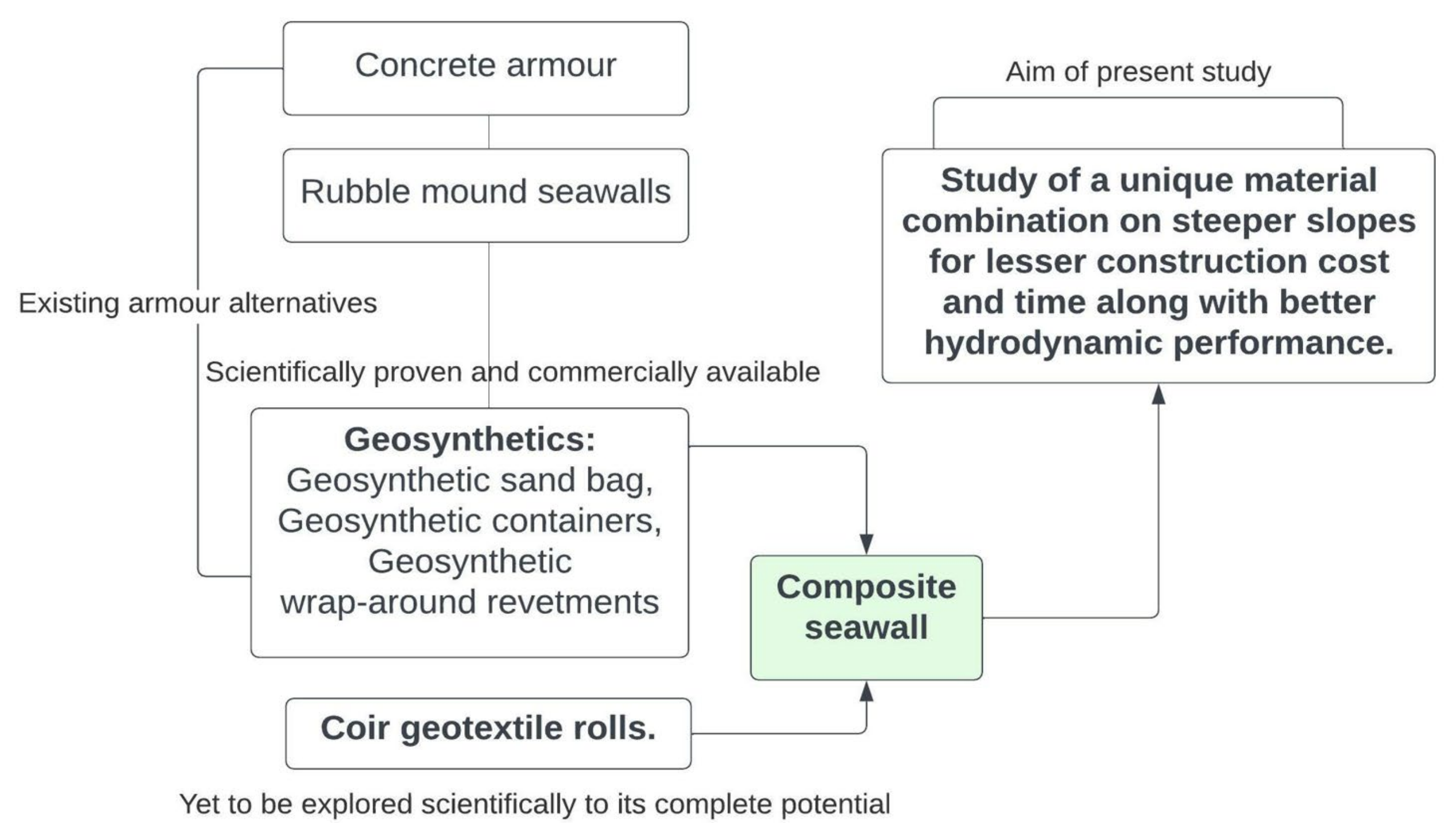
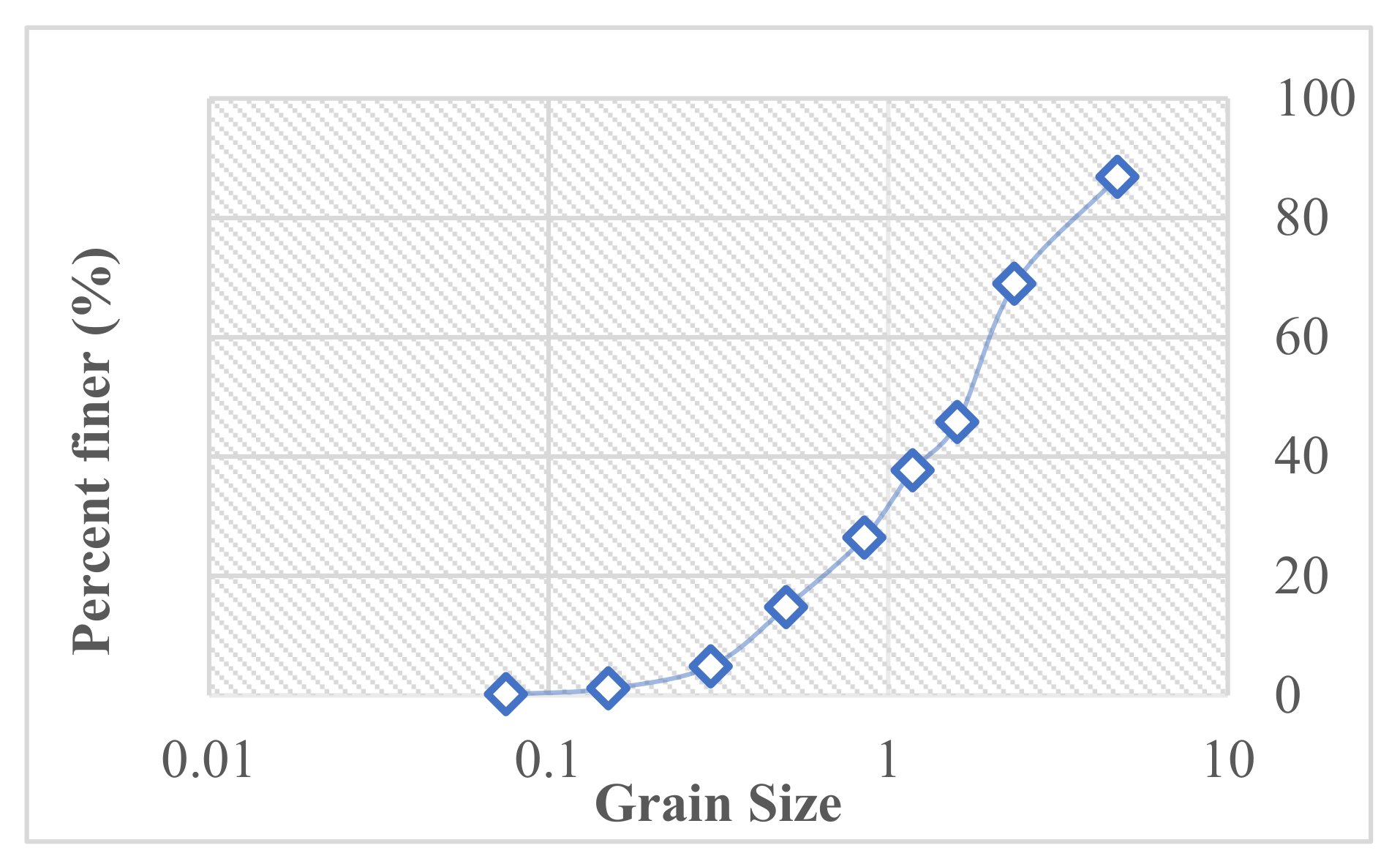
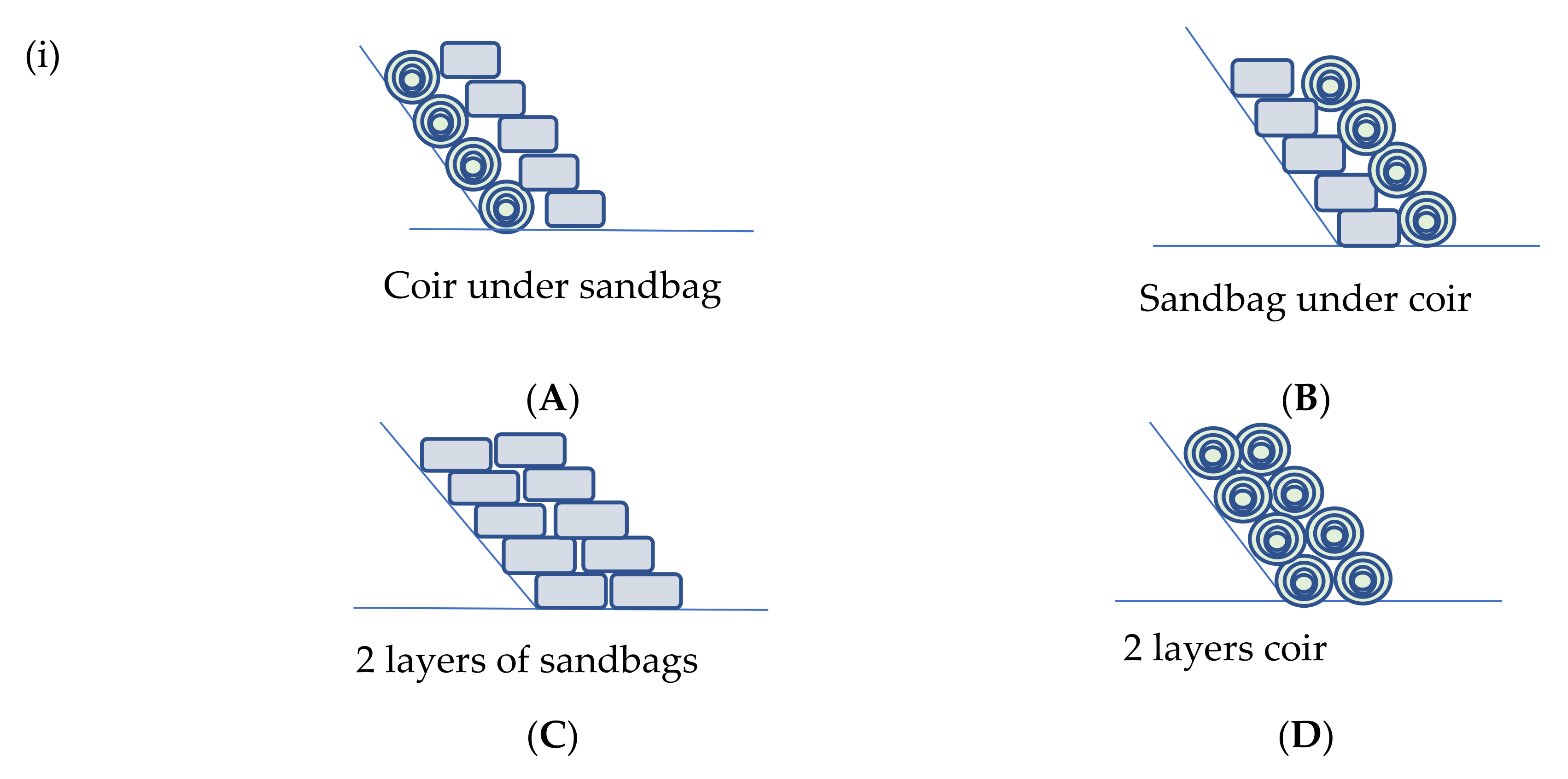
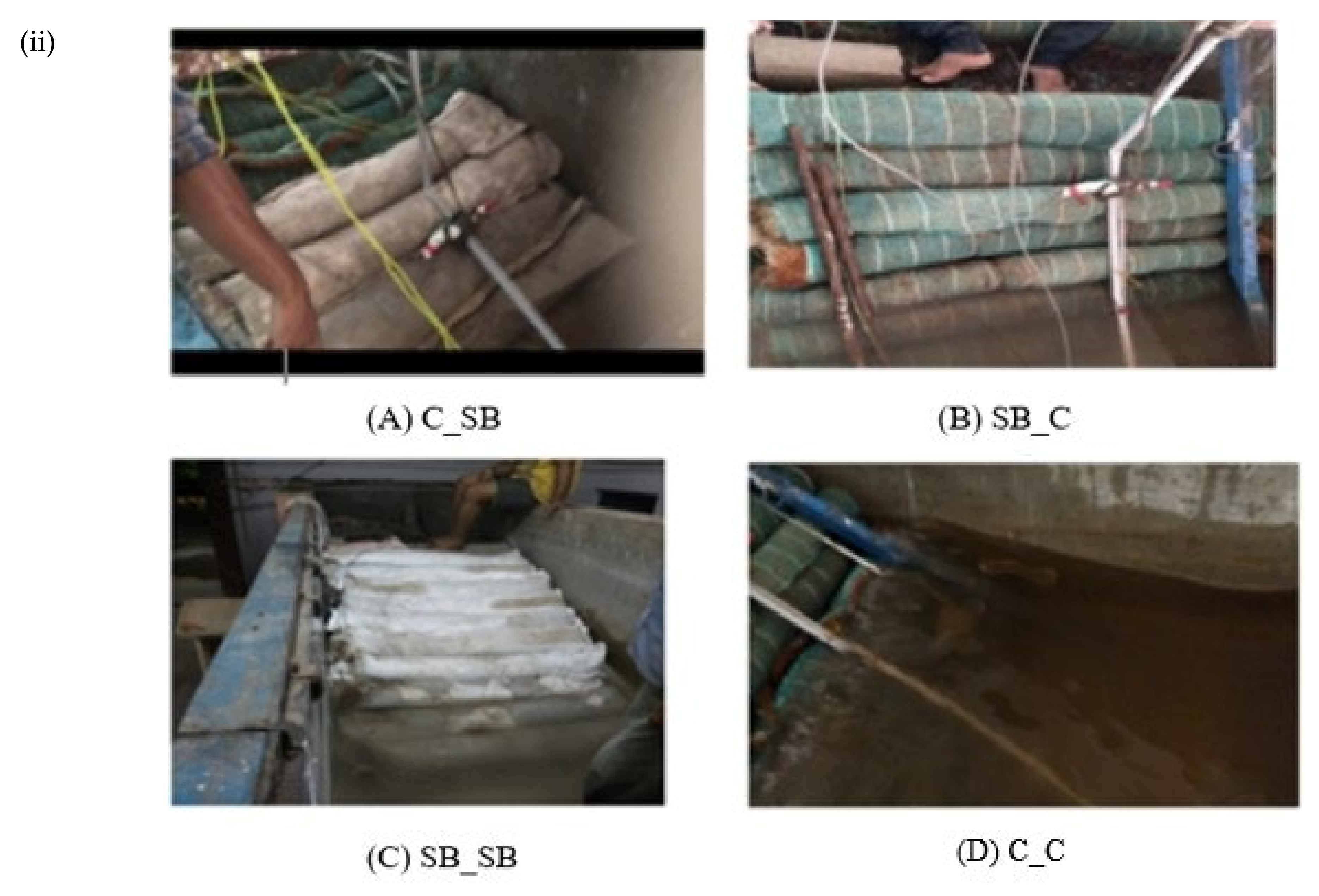

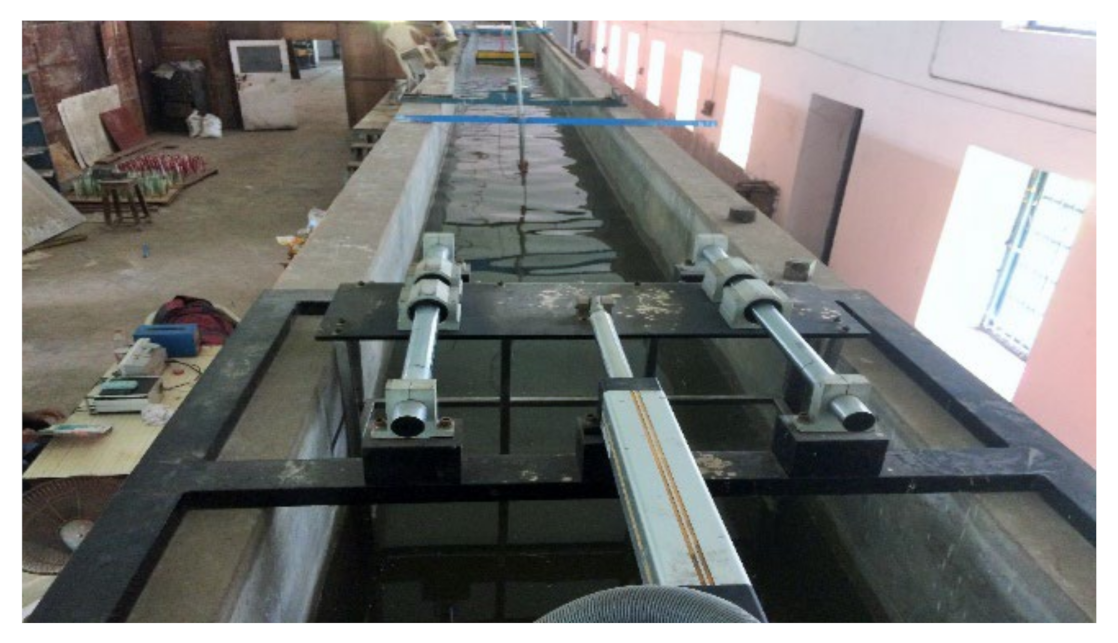

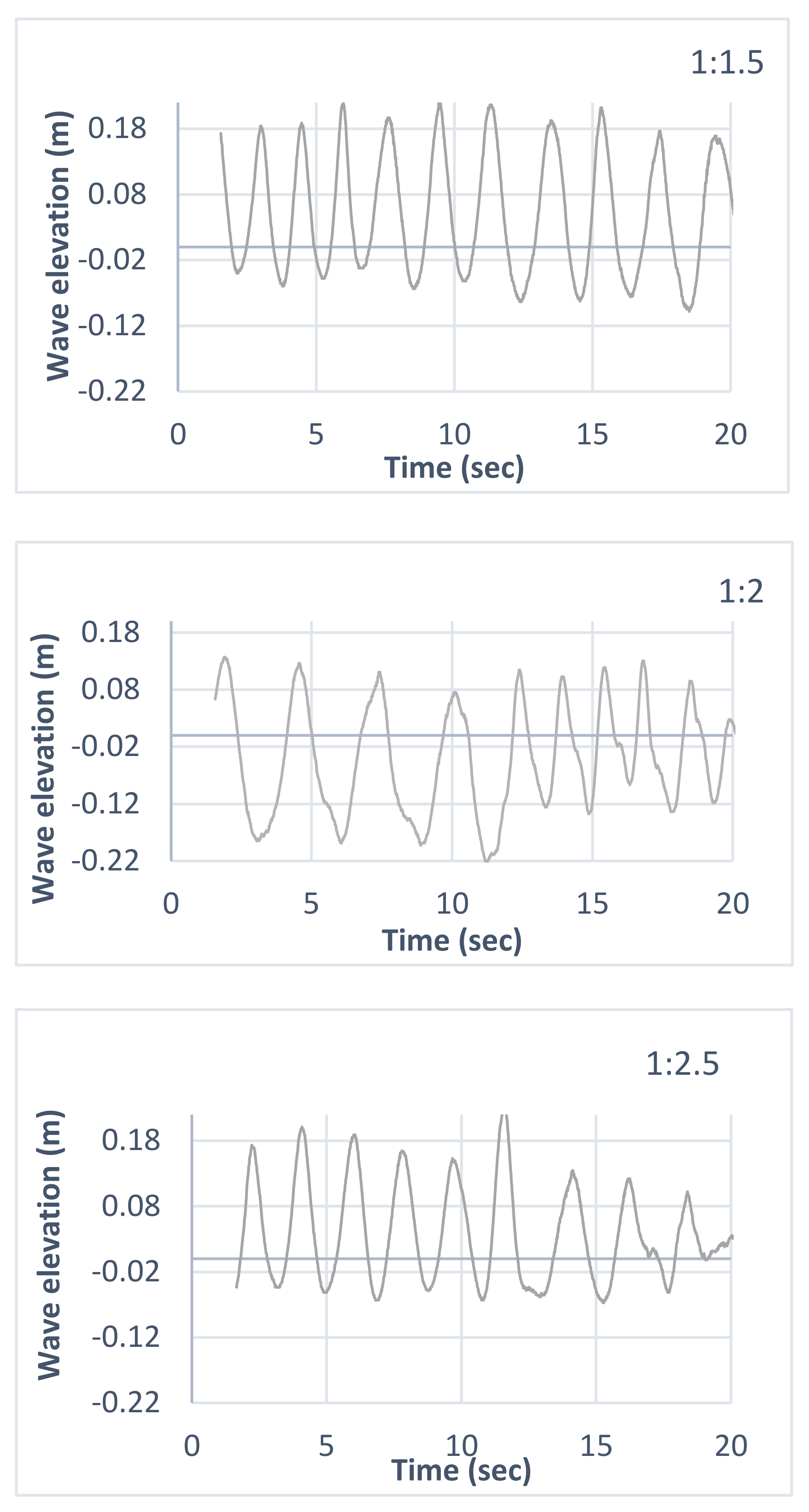
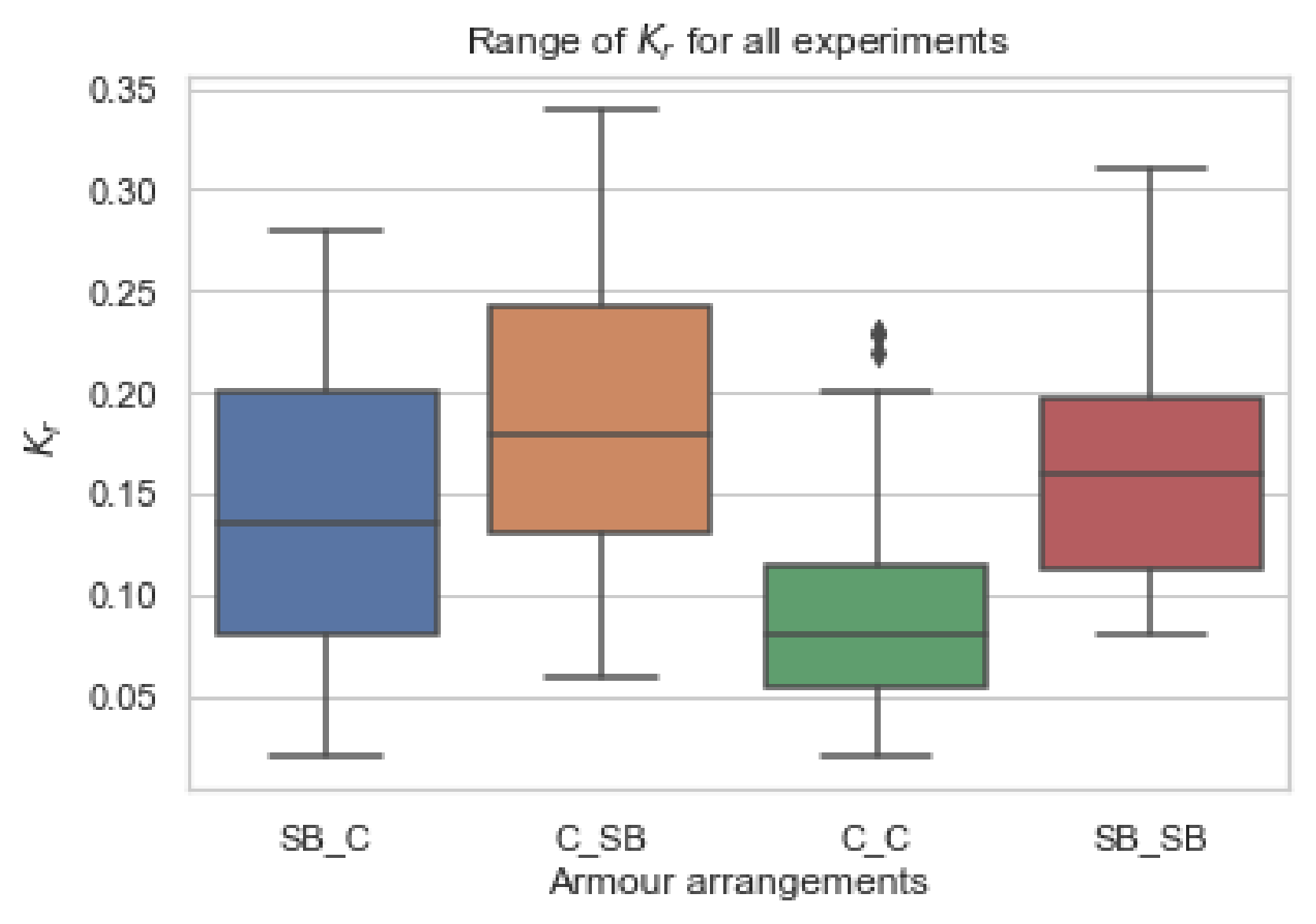
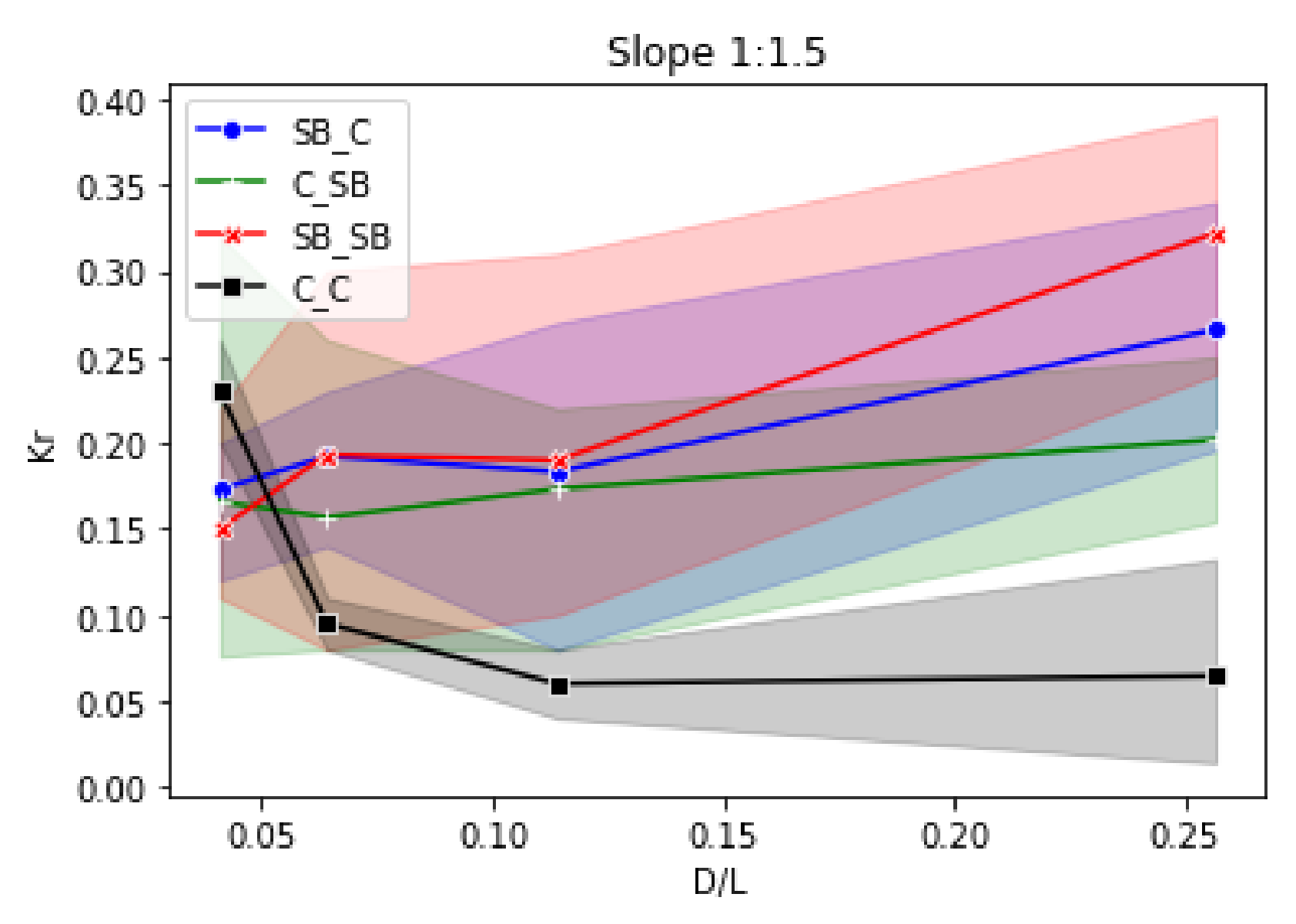
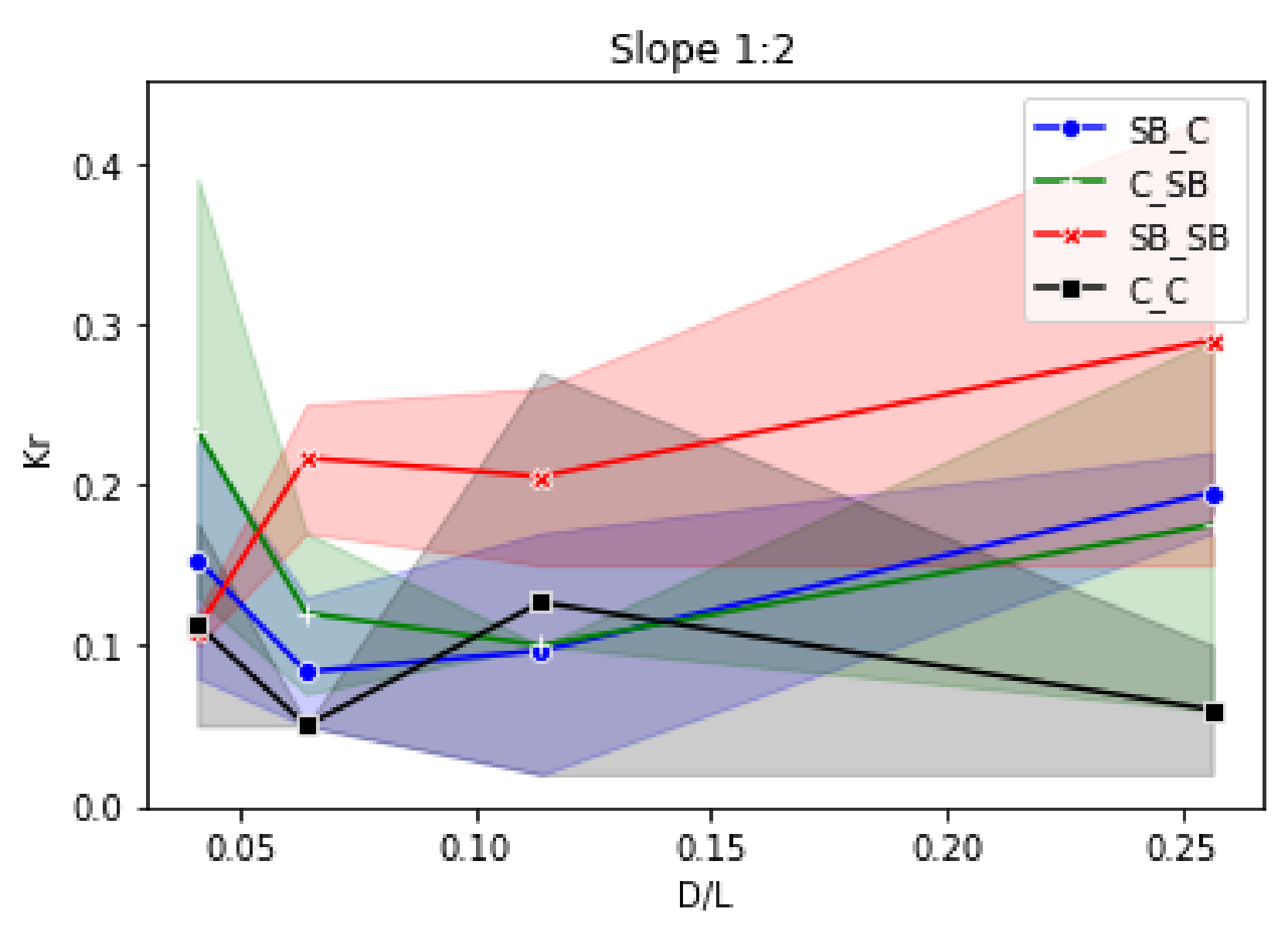
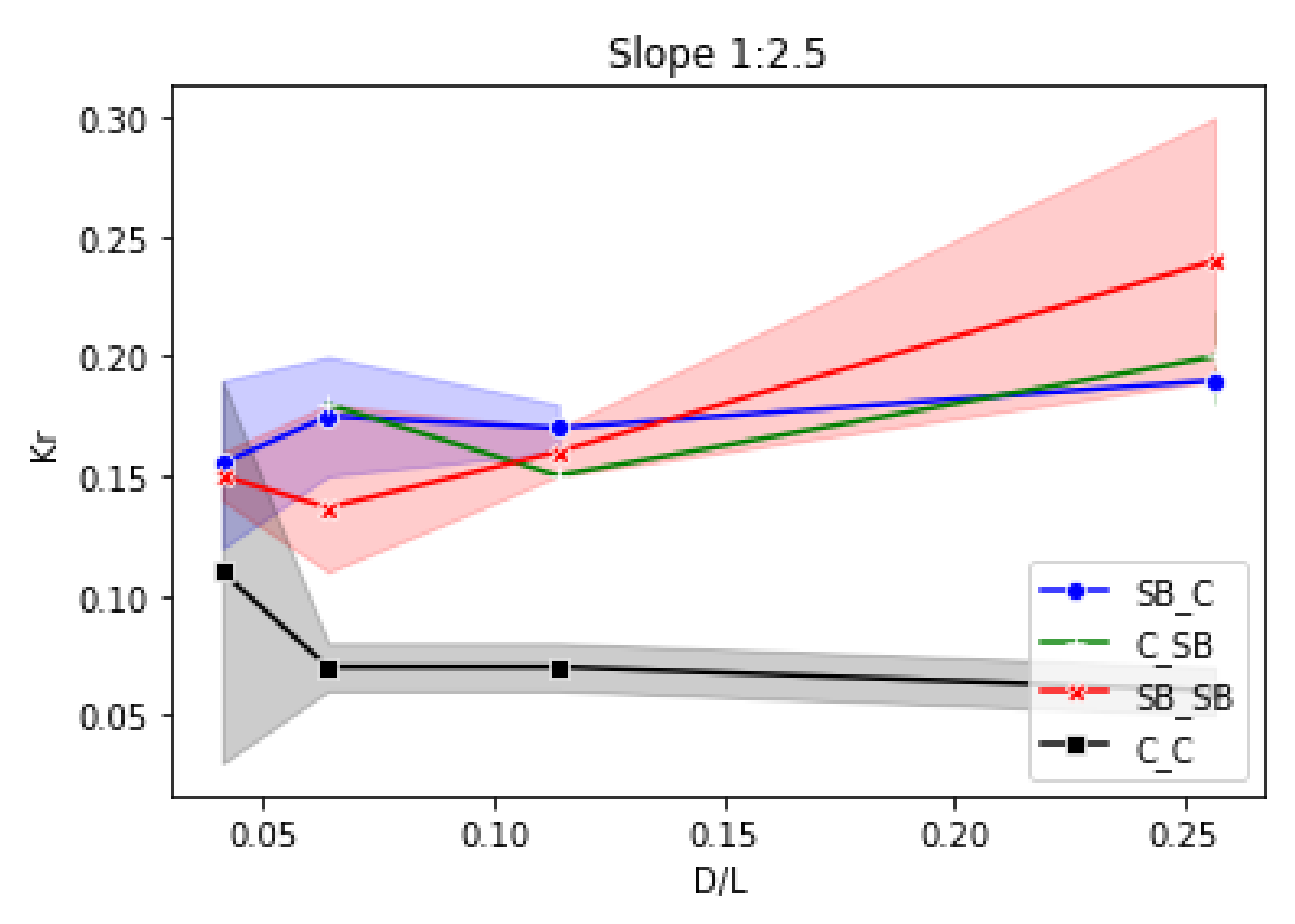
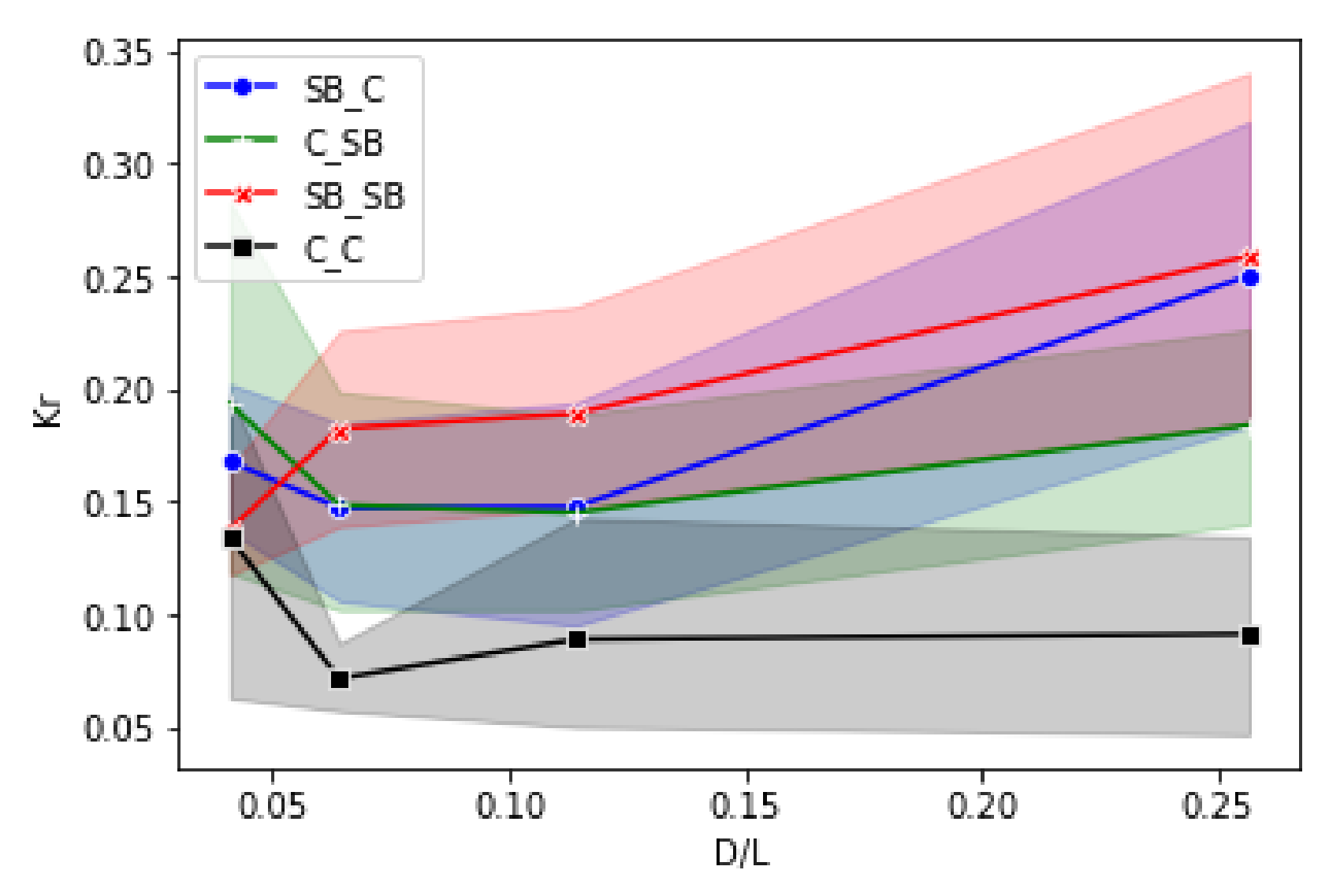

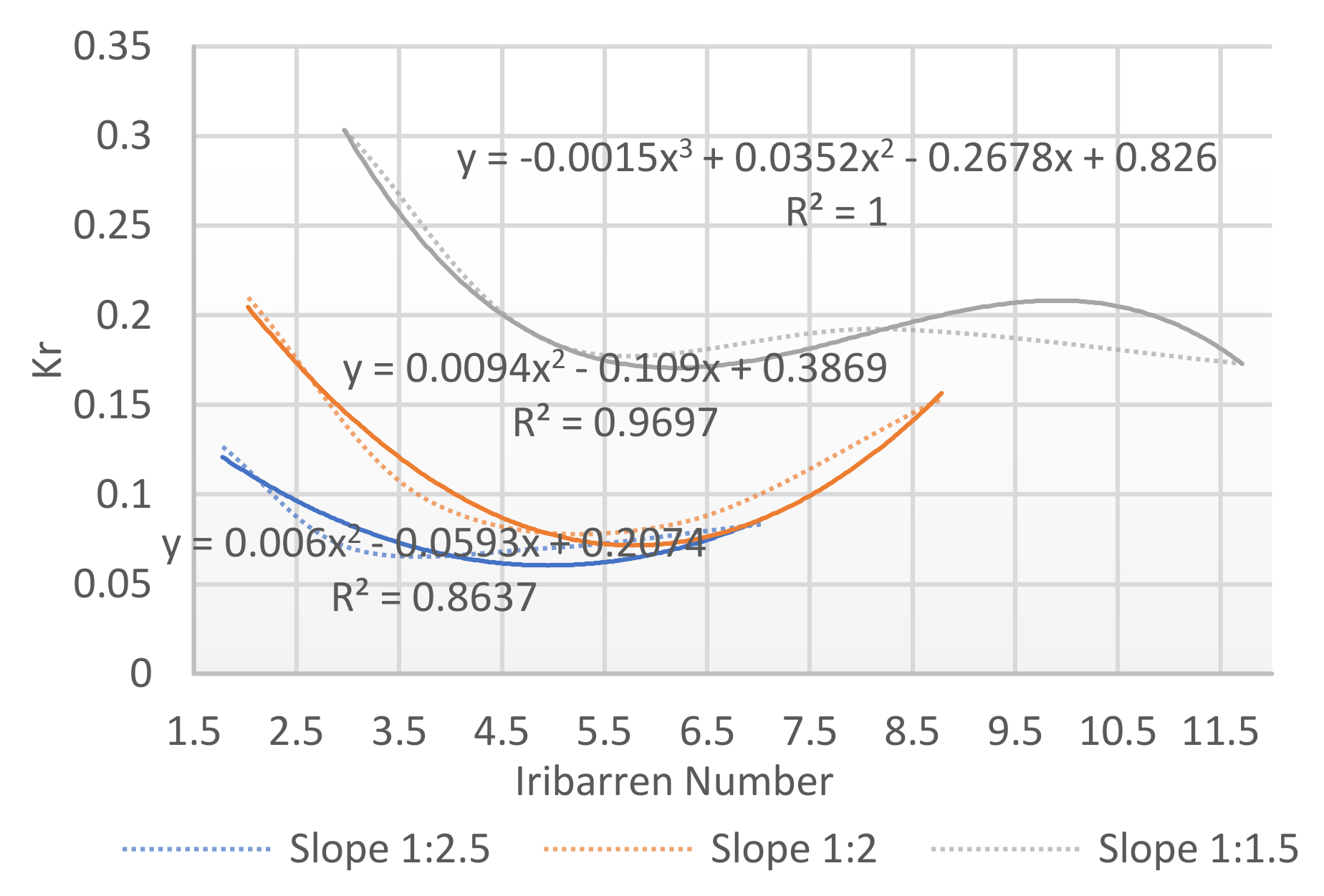
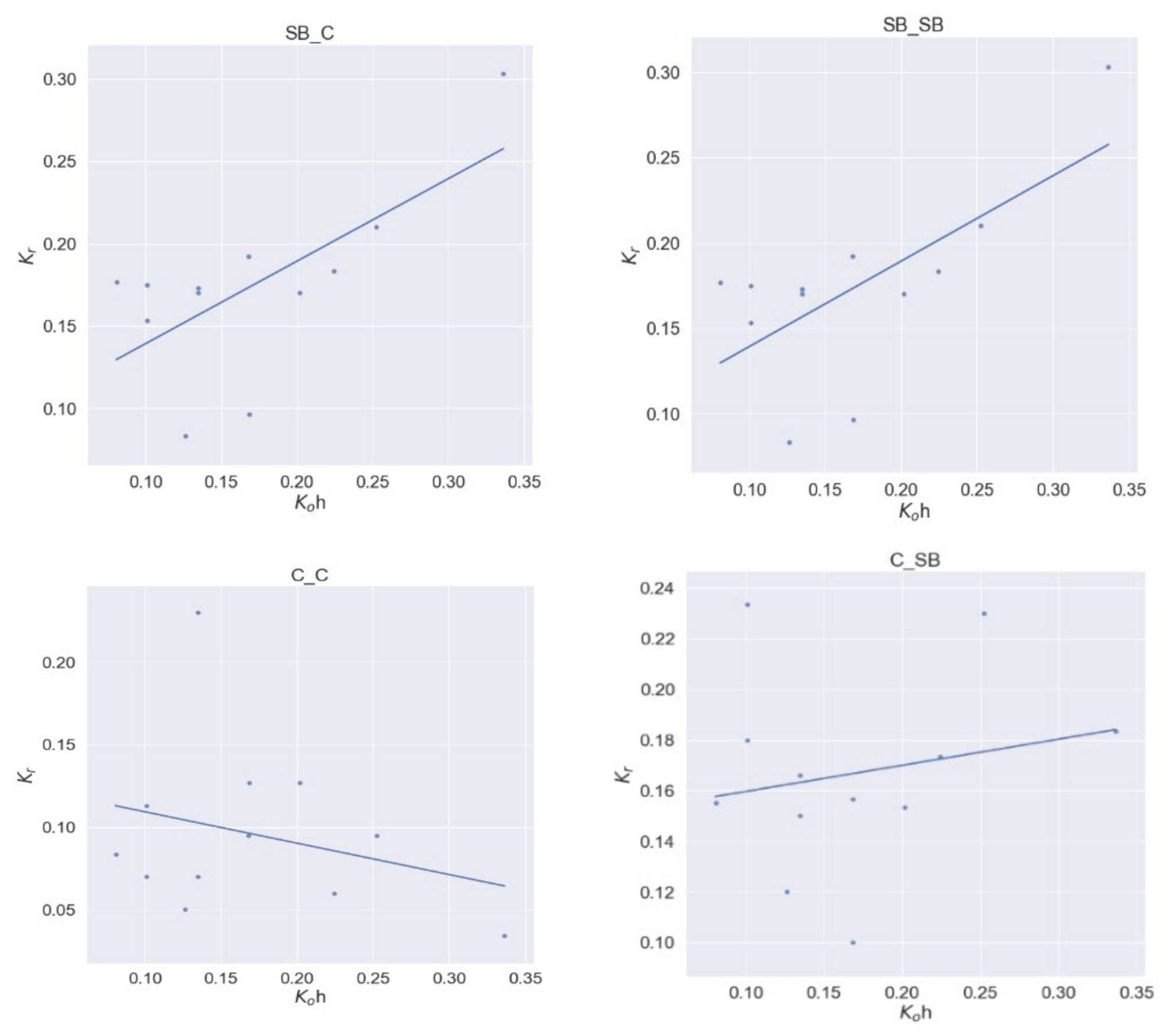
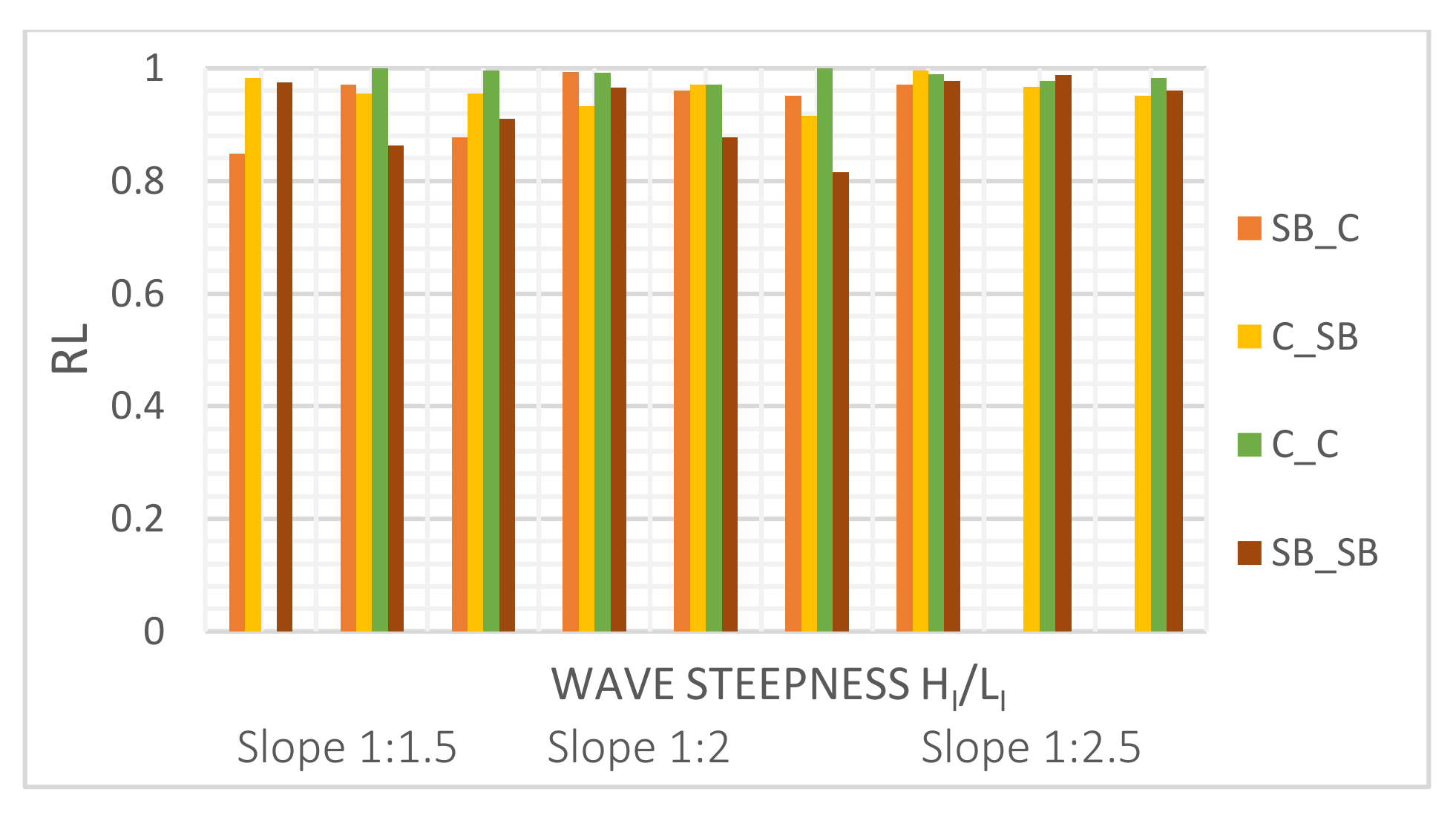
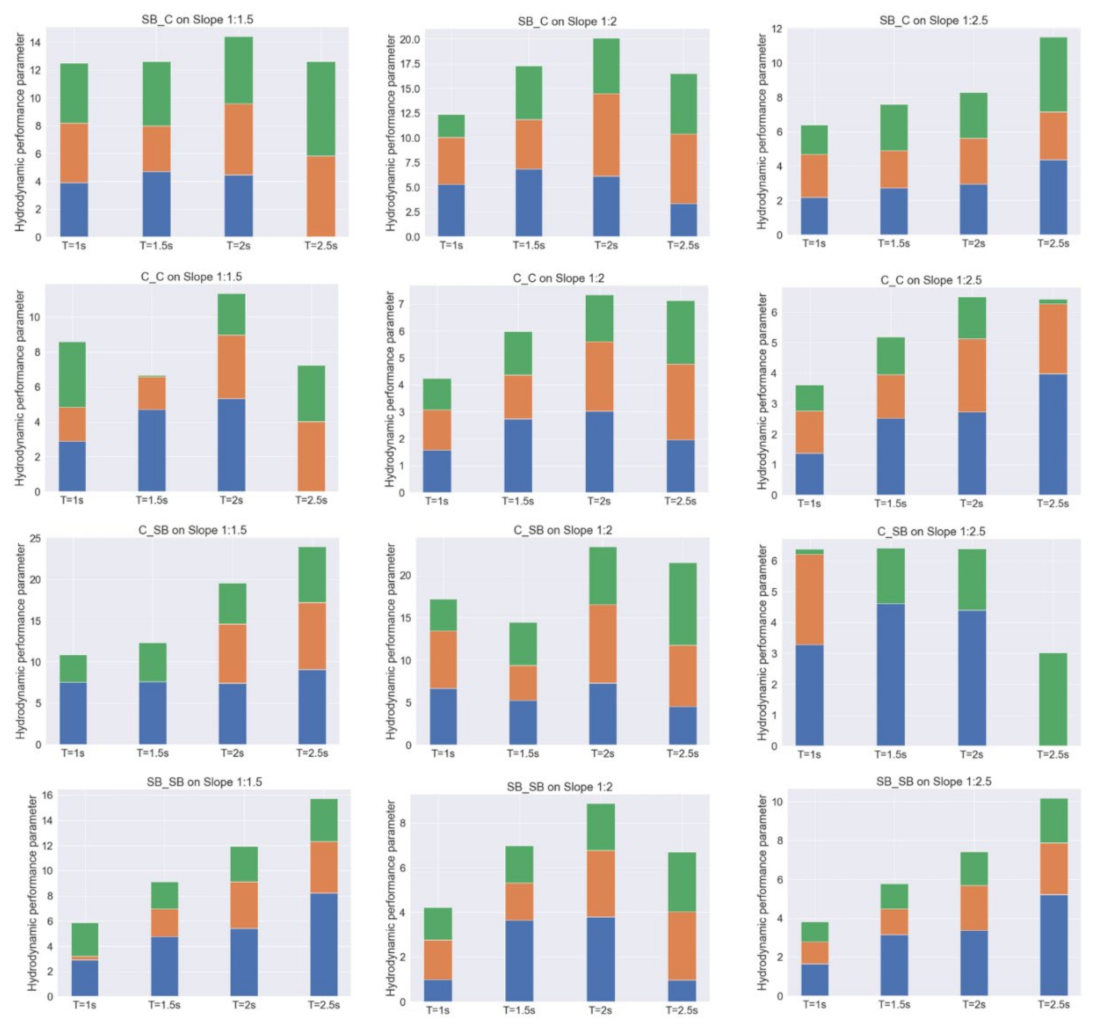
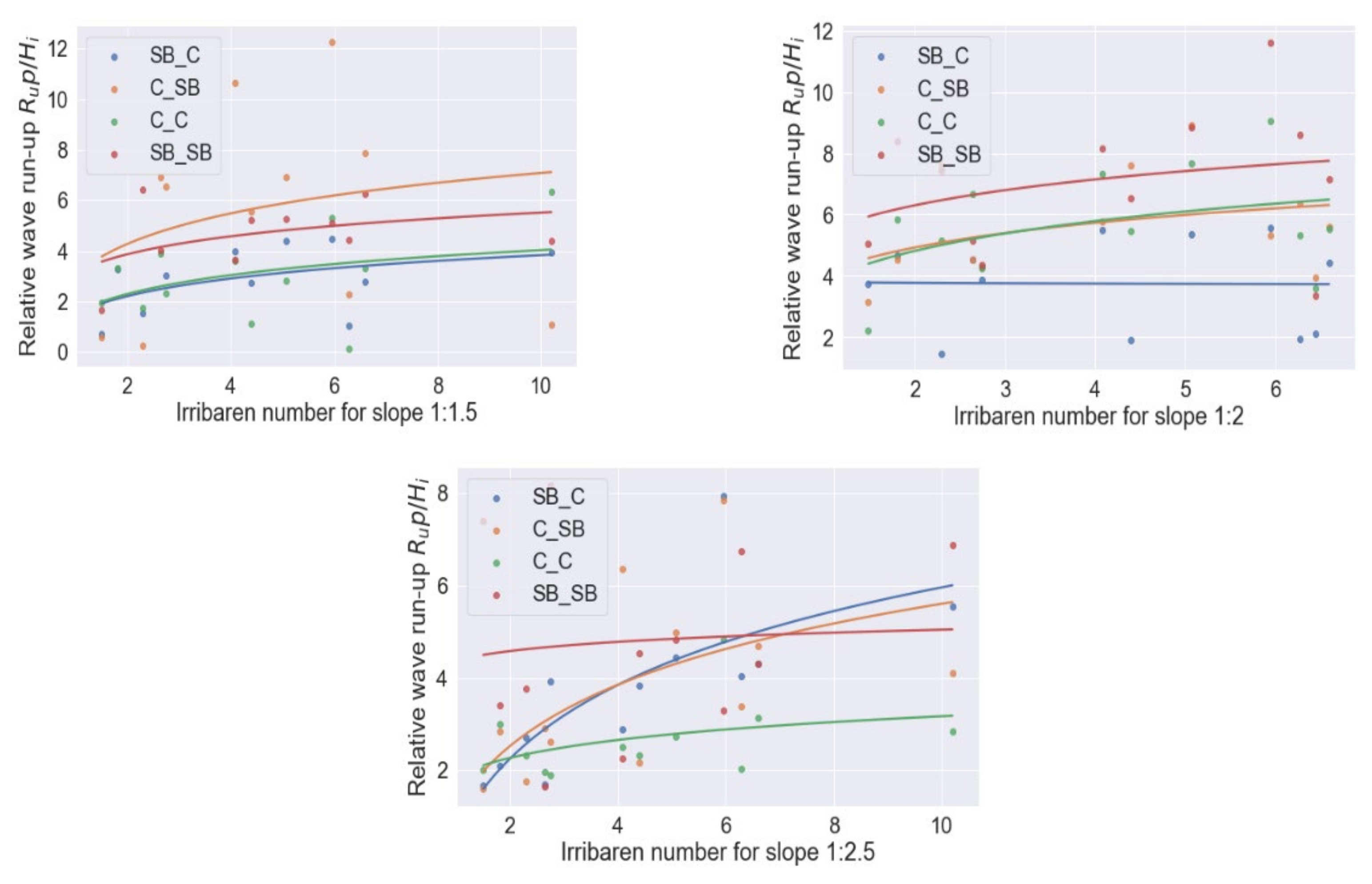
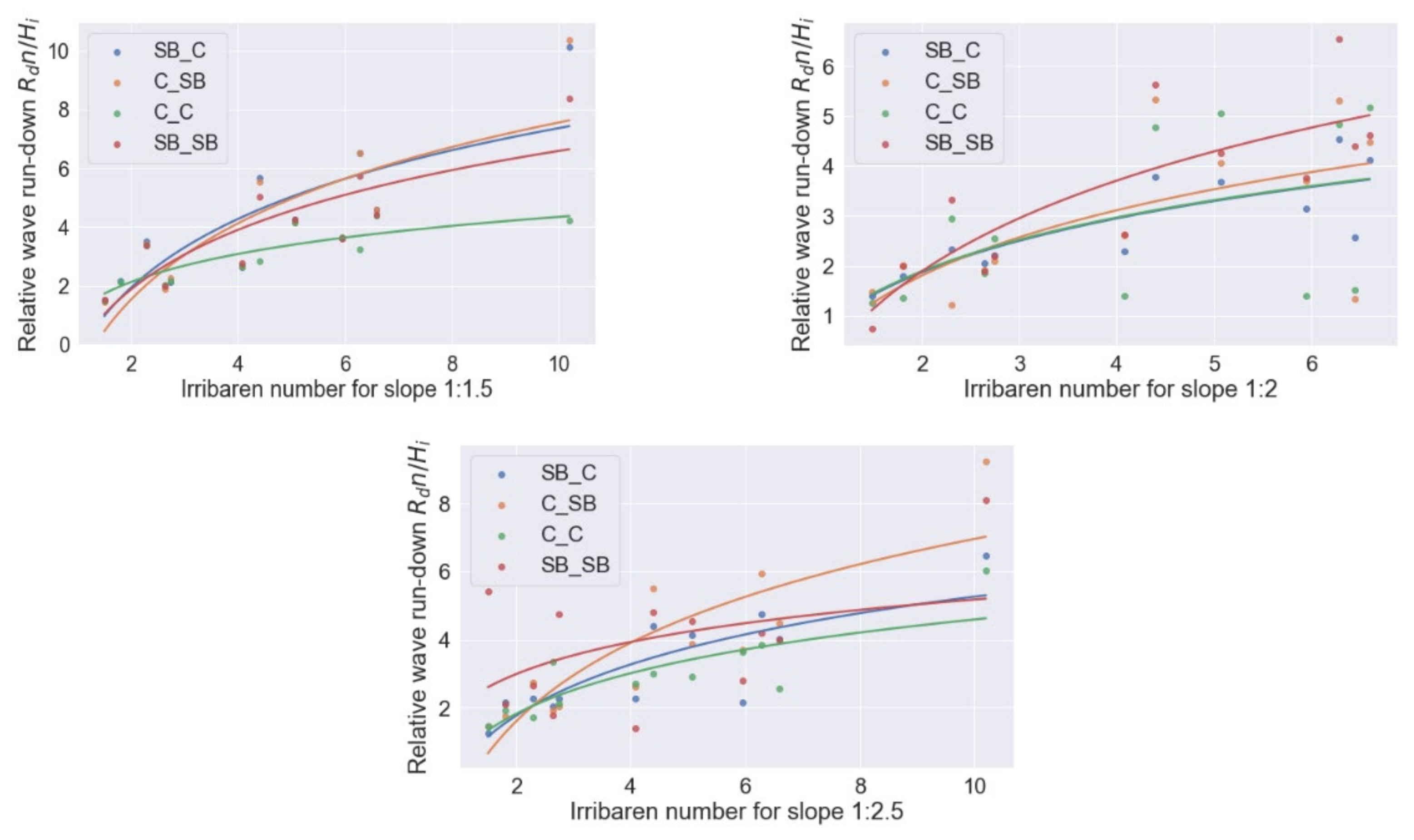
| Symbol | Value/Ranges | Unit |
|---|---|---|
| D | 30 | cm |
| Li | 156 to 975 | cm |
| Hi | 3–20 | cm |
| T | 1–2.5 | s |
| Cot θ | 1.5, 2, 2.5 | - |
| Property | Units |
|---|---|
| CBR Puncture Strength | 3110 N |
| Trapezoidal Tear Strength | 450 N |
| Grab Tensile Strength | 1110 N |
| Grab Elongation | >50% |
| AOS | less than 75 micron |
| Water flow | 50 L/sqm/s |
| UV Resistance | 70% at 500 hrs of exposure |
| Property | Value | Units |
|---|---|---|
| Relative Density | 69.8 | % |
| Specific gravity | 2.68 | - |
| Permeability | 0.0134 | m/s |
| Cu | 5.12 | - |
| Cc | 1.09 | - |
| Ø | 30 | degrees |
| Property | Value | Units |
|---|---|---|
| Thickness | 10 | mm |
| GSM | 600 | - |
| Permeability | 11,860 | lit/m3/min |
| Arrangement | cotθ | Wave Conditions | Total Runs |
|---|---|---|---|
| C_SB | 1.5, 2, 2.5 | Three actuator amplitudes, 5 cm, 10 cm, and 15 cm, and four wave periods, 1 s, 1.5 s, 2 s, and 2.5 s, for each amplitude | 36 |
| SB_C | 1.5, 2, 2.5 | 36 | |
| SB_SB | 1.5, 2, 2.5 | 36 | |
| C_C | 1.5, 2, 2.5 | 36 |
| Parameter | Representation | Range of Value |
|---|---|---|
| Relative water depth | (D/Li) | 0.06–0.2 |
| Relative wave steepness | (Hi/Li) | 0.001–0.075 |
| Slope of seawall | Cot θ | 1.5, 2, 2.5 |
| Surf similarity parameter | 1.8–17 Plunging waves Surging waves | |
| Porosity of the structures | n | 0.4 for Geosynthetic sandbag 0.615 for the geocomposite 0.8 for coir rolls |
| Seawalls Design Criteria | |||
|---|---|---|---|
| Kr | Rup/Hi | Rdn/Hi | |
| 1. Detraction of dynamic and hydrostatic wave pressure on seawall face. | 1 | 1 | 0 |
| 2. Deterrence to the wave overtopping. | 0 | 1 | 0 |
| 3.Liquefaction mitigation and prevention of soil erosion in front of wall toe. | 1 | 0 | 1 |
| 4. Wave energy dissipation. | 1 | 0 | 0 |
| 5. Optimization of wave downfall pressure in front of the wall. | 1 | 0 | 1 |
| 6. Lowering of the potential crest level. | 0 | 1 | 0 |
| 7. Climate change and sea level rise (SLR) adaptation | 1 | 1 | 1 |
| 8. Reduction of thickness of armor layer | 1 | 1 | 0 |
| 9. Toe layer optimization | 1 | 0 | 1 |
| Overall weights | 7/9 | 5/9 | 4/9 |
| 0.77 | 0.55 | 0.44 | |
| Hydrodynamic Performance Parameters | Weight (wt) | Value of Reflection (V) | Amplitude (A) 10 | Period (T) 2.5 | |||
|---|---|---|---|---|---|---|---|
| Cot θ = 1.5 | Cot θ = 2 | Cot θ = 2.5 | |||||
| (wt) | V | V* wt | V | V* wt | V | V* wt | |
| Kr | 0.77 | 0.23 | 0.17 | 0.05 | 0.03 | 0.19 | 0.146 |
| Rup/Hi | 0.55 | 2.7 | 1.48 | 6.53 | 3.59 | 0.63 | 0.34 |
| Rdn/Hi | 0.44 | 2.95 | 1.29 | 0.45 | 0.198 | 2.00 | 0.88 |
| Cumulative count | 2.94 | 3.818 | 1.366 | ||||
| ANOVA | ||||||||
|---|---|---|---|---|---|---|---|---|
| df | SS | MS | F | Significance F | ||||
| Regression | 3 | 2.103543 | 0.701181 | 15.52514412 | 2.99 × 10−8 | |||
| Residual | 92 | 4.155108 | 0.045164 | |||||
| Total | 95 | 6.258651 | ||||||
| Coefficients | Standard Error | t Stat | p-value | Lower 95% | Upper 95% | Lower 95.0% | Upper 95.0% | |
| Intercept | −0.22053 | 0.136067 | 1.62072 | 0.108500 | −0.49077 | 0.049714 | −0.4907 | 0.04971 |
| Ho/gt2 | 27.76432 | 6.343589 | 4.37675 | 3.177 × 10−5 | 15.1654 | 40.36323 | 15.1654 | 40.3632 |
| Cot Theta | −0.15411 | 0.053693 | 2.87014 | 0.005090 | −0.26074 | −0.047467 | −0.26074 | −0.04746 |
| Porosity | −0.7048 | 0.184747 | 3.81493 | 0.000246 | −1.07172 | −0.337873 | −1.07172 | −0.33787 |
Publisher’s Note: MDPI stays neutral with regard to jurisdictional claims in published maps and institutional affiliations. |
© 2022 by the authors. Licensee MDPI, Basel, Switzerland. This article is an open access article distributed under the terms and conditions of the Creative Commons Attribution (CC BY) license (https://creativecommons.org/licenses/by/4.0/).
Share and Cite
Dabir, V.; Khare, K.; Munireddy, M.G. A Composite Permeable Sloping Seawall for Effective Energy Dissipation: A Quasi-Soft Alternative Solution for Shore Protection. J. Mar. Sci. Eng. 2022, 10, 1423. https://doi.org/10.3390/jmse10101423
Dabir V, Khare K, Munireddy MG. A Composite Permeable Sloping Seawall for Effective Energy Dissipation: A Quasi-Soft Alternative Solution for Shore Protection. Journal of Marine Science and Engineering. 2022; 10(10):1423. https://doi.org/10.3390/jmse10101423
Chicago/Turabian StyleDabir, Vaishnavi, Kanchan Khare, and Mutukuru Gangireddy Munireddy. 2022. "A Composite Permeable Sloping Seawall for Effective Energy Dissipation: A Quasi-Soft Alternative Solution for Shore Protection" Journal of Marine Science and Engineering 10, no. 10: 1423. https://doi.org/10.3390/jmse10101423
APA StyleDabir, V., Khare, K., & Munireddy, M. G. (2022). A Composite Permeable Sloping Seawall for Effective Energy Dissipation: A Quasi-Soft Alternative Solution for Shore Protection. Journal of Marine Science and Engineering, 10(10), 1423. https://doi.org/10.3390/jmse10101423






